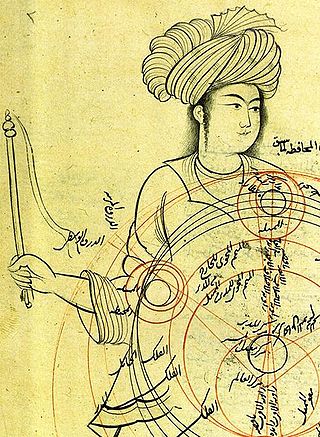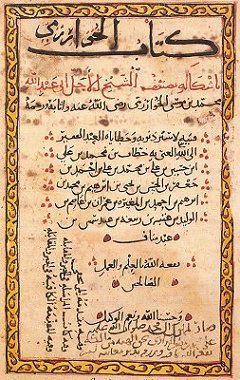Related Research Articles
Abu Nasri Mansur ibn Ali ibn Iraq al-Jaʿdī was a Persian Muslim mathematician and astronomer. He is well known for his work with the spherical sine law.
Abu Mahmud Hamid ibn al-Khidr al-Khujandi was a Muslim Transoxanian astronomer and mathematician born in Khujand who lived in the late 10th century and helped build an observatory, near the city of Ray, in Iran.
Sharaf al-Dīn al-Muẓaffar ibn Muḥammad ibn al-Muẓaffar al-Ṭūsī known more often as Sharaf al-Dīn al-Ṭūsī or Sharaf ad-Dīn aṭ-Ṭūsī, was an Iranian mathematician and astronomer of the Islamic Golden Age.
Abu Zayd Ahmed ibn Sahl Balkhi was a Persian Muslim polymath: a geographer, mathematician, physician, psychologist and scientist. Born in 850 CE in Shamistiyan, in the province of Balkh, Greater Khorasan, he was a disciple of al-Kindi. He also founded the "Balkhī school" of terrestrial mapping in Baghdad. Al-Balkhi is believed to have been the first to diagnose that mental illness can have psychological and physiological causes and he was the first to typify four types of emotional disorders: fear and anxiety; anger and aggression; sadness and depression; and obsessions.

Qotb al-Din Mahmoud b. Zia al-Din Mas'ud b. Mosleh Shirazi was a 13th-century Persian polymath and poet who made contributions to astronomy, mathematics, medicine, physics, music theory, philosophy and Sufism.
This timeline of science and engineering in the Muslim world covers the time period from the eighth century AD to the introduction of European science to the Muslim world in the nineteenth century. All year dates are given according to the Gregorian calendar except where noted.

Mathematics during the Golden Age of Islam, especially during the 9th and 10th centuries, was built on Greek mathematics and Indian mathematics. Important progress was made, such as full development of the decimal place-value system to include decimal fractions, the first systematised study of algebra, and advances in geometry and trigonometry.

Medieval Islamic astronomy comprises the astronomical developments made in the Islamic world, particularly during the Islamic Golden Age, and mostly written in the Arabic language. These developments mostly took place in the Middle East, Central Asia, Al-Andalus, and North Africa, and later in the Far East and India. It closely parallels the genesis of other Islamic sciences in its assimilation of foreign material and the amalgamation of the disparate elements of that material to create a science with Islamic characteristics. These included Greek, Sassanid, and Indian works in particular, which were translated and built upon.
Shams al-Dīn Muḥammad ibn Ashraf al-Ḥusaynī al-Samarqandī was a 13th century Persian astronomer and mathematician from Samarkand, now in Uzbekistan.
Balkhi may refer to:
Shams al-Din is an Arabic personal name or title.
Medieval Islamic geography and cartography refer to the study of geography and cartography in the Muslim world during the Islamic Golden Age. Muslim scholars made advances to the map-making traditions of earlier cultures, particularly the Hellenistic geographers Ptolemy and Marinus of Tyre, combined with what explorers and merchants learned in their travels across the Old World (Afro-Eurasia). Islamic geography had three major fields: exploration and navigation, physical geography, and cartography and mathematical geography. Islamic geography reached its apex with Muhammad al-Idrisi in the 12th century.
Tazkirat al-Awliyā – variant transliterations: Tazkirat al-Awliyā`, Tadhkirat al-Awliya, Tazkerat-ol-Owliya, Tezkereh-i-Evliā etc., – is a hagiographic collection of ninety-six Sufi saints and their miracles (Karamat) by the twelfth–thirteenth-century Persian poet and mystic, Farīd al-Dīn ‘Aṭṭar. ‘Aṭṭar's only surviving prose work comprises 72-chapters, beginning with the life of Jafar Sadiq, the Sixth Shia Imam, and ending with the Sufi Martyr, Mansur Al-Hallaj's.

Muhammad ibn Muhammad ibn al-Hasan al-Tusi, also known as Nasir al-Din al-Tusi or simply as (al-)Tusi, was a Persian polymath, architect, philosopher, physician, scientist, and theologian. Nasir al-Din al-Tusi was a well published author, writing on subjects of math, engineering, prose, and mysticism. Additionally, al-Tusi made several scientific advancements. In astronomy, al-Tusi created very accurate tables of planetary motion, an updated planetary model, and critiques of Ptolemaic astronomy. He also made strides in logic, mathematics but especially trigonometry, biology, and chemistry. Nasir al-Din al-Tusi left behind a great legacy as well. Tusi is widely regarded as one of the greatest scientists of medieval Islam, since he is often considered the creator of trigonometry as a mathematical discipline in its own right. The Muslim scholar Ibn Khaldun (1332–1406) considered Tusi to be the greatest of the later Persian scholars. There is also reason to believe that he may have influenced Copernican heliocentrism.
Marwazi or al-Marwazi is a nisba meaning "from Merv", a historical city in, near today's Mary in Turkmenistan. It may refer to:
References
- ↑ "Mathematician has top medal stolen half an hour after winning it". euronews. 2018-08-02. Retrieved 2018-08-08.
- ↑ "Médaille Fields: Un Iranien, un Italien, un Allemand et un Indo-Australien ont obtenu la prestigieuse récompense". www.20minutes.fr (in French). Retrieved 2018-08-05.
- ↑ "Prof. Rama Cont" . Retrieved 2018-09-20.
- ↑ "Prix Louis Bachelier de la Fondation Natixis pour la recherche quantitative et de la SMAI - les grands Prix de l'Académie des sciences". Archived from the original on 2014-10-26. Retrieved 2014-08-13.
- ↑ Abbas Edalat's Home Page Archived 2007-01-16 at the Wayback Machine
- ↑ "Esfandiar Maasoumi, Ph.D." Archived from the original on 2006-08-16.
- ↑ Jacobson, Howard (July 29, 2017). "The world has lost a great artist in mathematician Maryam Mirzakhani". The Guardian. Retrieved 31 July 2017.